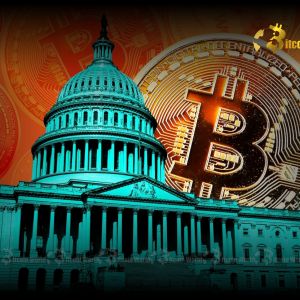Crypto Regulation: US Congress Gears Up for Pivotal Stablecoin & Digital Asset Votes
5 min read
The cryptocurrency world is buzzing, and for good reason. Major legislative shifts are on the horizon, with the U.S. Congress taking decisive steps towards shaping the future of crypto regulation . Are we on the cusp of a new era for digital assets, or will political hurdles slow down progress? The coming weeks are set to be pivotal, as lawmakers in both the House and Senate tackle critical bills that could redefine how cryptocurrencies operate within the American financial system. What’s the Buzz Around the Stablecoin Bill? One of the most significant pieces of legislation making waves is the Senate’s advancement of a comprehensive stablecoin bill , known as the GENIUS Act. This bill aims to provide a clear regulatory framework for stablecoin issuers, a move long awaited by the industry. Stablecoins, designed to maintain a stable value relative to a fiat currency like the U.S. dollar, have become a cornerstone of the crypto economy, facilitating trades and offering a bridge between traditional finance and decentralized systems. The GENIUS Act’s passage through the Senate with strong bipartisan support signals a growing recognition among lawmakers of the importance of digital assets. For years, the lack of clear guidelines has created uncertainty, hindering innovation and institutional adoption. This bill seeks to address that by: Establishing robust consumer protection measures. Setting capital requirements for issuers to ensure stability. Defining oversight responsibilities for federal agencies. The successful advancement of this bill is a monumental step, potentially paving the way for greater clarity and confidence in the stablecoin market. It’s a testament to the persistent efforts of industry advocates and forward-thinking legislators who understand the need for regulatory clarity in a rapidly evolving financial landscape. Will the US House Crypto Votes Bring Clarity? With the Senate’s stablecoin bill now on the House’s radar, attention is rapidly shifting to the U.S. House of Representatives. There’s strong anticipation that the House may vote on the Senate’s bill as early as next week. This potential vote is part of a broader push by the Trump administration to advance two major crypto laws this summer, aiming to solidify the U.S. position in the global digital asset space. Beyond the stablecoin legislation, the US House crypto agenda includes the much-anticipated Clarity Act. This bill focuses on broader crypto market structure, aiming to define which digital assets are securities and which are commodities. Such clarity is crucial for developers, investors, and exchanges, as it would determine which regulatory body—the SEC or the CFTC—has jurisdiction over specific tokens. The current ambiguity has led to numerous enforcement actions and a chilling effect on innovation within the U.S. The House’s willingness to engage with these complex issues demonstrates a bipartisan effort to establish a comprehensive framework. However, the path forward is not without its challenges, as different factions within Congress hold varying views on the extent and nature of crypto regulation. The outcomes of these votes could significantly impact the operational landscape for crypto businesses and the accessibility of digital assets for everyday Americans. What Challenges Lie Ahead for Senate Crypto Approval? While the momentum for crypto regulation seems strong, particularly with the Senate’s initial approval of the stablecoin bill, final legislative success is far from guaranteed. The journey through the Senate, especially for broader market structure bills like the Clarity Act or any House-amended version of the stablecoin bill, remains uncertain. Several key concerns continue to loom large, creating potential roadblocks. A primary hurdle is ensuring adequate consumer protection. Lawmakers are grappling with how to balance innovation with safeguarding investors from potential risks, scams, and market volatility. There’s a strong desire to prevent a repeat of past industry failures and ensure that new regulations are robust enough to protect the public without stifling growth. Another factor drawing scrutiny is former President Trump’s ties to the crypto industry. His recent embrace of digital assets, including accepting campaign donations in crypto and his stated intent to champion the sector, has raised questions among some lawmakers regarding potential conflicts of interest or undue influence. While his support could accelerate legislative efforts, it also invites closer examination and potential political pushback. The Senate’s deliberative nature and the need for broad consensus mean that even bills with initial support can face significant amendments or delays. Achieving final approval will require careful negotiation and compromise to address the diverse concerns of senators from across the political spectrum. Why the Push for a CBDC Ban? Amidst the discussions on stablecoins and broader market structure, lawmakers are also actively planning to address a bill specifically banning a U.S. central bank digital currency ( CBDC ban ). This initiative reflects a growing sentiment among some policymakers who view a government-issued digital dollar with skepticism, citing concerns over privacy, government overreach, and the potential impact on the existing banking system. Proponents of a CBDC often highlight potential benefits such as increased financial inclusion, faster payment processing, and enhanced monetary policy tools. However, opponents argue that a CBDC could lead to: Surveillance Risks: The ability for the government to track individual transactions, raising significant privacy concerns. Disintermediation of Banks: A potential shift of deposits from commercial banks to the central bank, disrupting the traditional banking model. Centralization of Power: Giving the government unprecedented control over financial flows. The debate around a CBDC is highly polarized, touching upon fundamental questions about the role of government in finance and individual liberties. The legislative push for a ban underscores the deep divisions on this issue and highlights the desire of some lawmakers to protect the current financial architecture and individual financial autonomy. The Road Ahead: Navigating Crypto’s Legislative Future The legislative landscape for cryptocurrencies in the U.S. is undeniably complex, yet it is also ripe with opportunity. The advancements of the stablecoin bill in the Senate and the anticipated US House crypto votes on market structure and a CBDC ban signify a turning point. Lawmakers are no longer just observing; they are actively shaping the regulatory environment. For the crypto industry, this period demands vigilance and engagement. Clear, thoughtful regulation can unlock unprecedented growth, attracting institutional investment and fostering mainstream adoption. Conversely, poorly conceived legislation could stifle innovation and push development offshore. The balance lies in crafting rules that protect consumers and maintain financial stability while allowing for the inherent dynamism of blockchain technology. As these crucial debates unfold, the outcomes will not only determine the future of digital assets in the United States but also set a precedent for global crypto regulation . Stakeholders, from developers to investors, must stay informed and advocate for frameworks that foster a secure, innovative, and accessible digital economy. The next few weeks and months will be defining moments for cryptocurrency in America. To learn more about the latest crypto regulation trends, explore our article on key developments shaping digital asset institutional adoption.

Source: Bitcoin World



